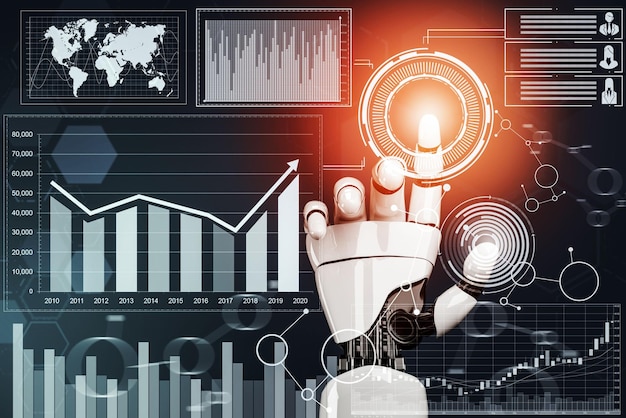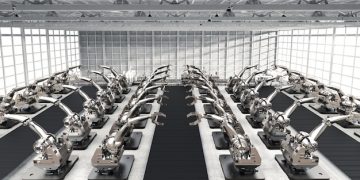AI and Automation: Transforming US Jobs in the Future of Work

AI and automation are significantly reshaping the US job market by automating tasks, creating new roles, and requiring workers to adapt to technological advancements in the future of work.
The relentless march of technological progress, spearheaded by AI and automation, are transforming US jobs, creating both challenges and opportunities for the American workforce. Understanding these shifts is crucial for workers, policymakers, and businesses alike.
Understanding the Rise of AI and Automation
Artificial intelligence (AI) and automation are no longer futuristic concepts; they are integral parts of today’s world. These technologies are rapidly evolving and being implemented across various industries, impacting how work is done and the skills required to succeed.
Automation refers to the use of machines and software to perform tasks previously done by humans. AI, on the other hand, involves creating computer systems that can perform tasks that typically require human intelligence, such as learning, problem-solving, and decision-making.
Key Drivers of AI and Automation Adoption
Several factors are driving the increasing adoption of AI and automation in the US job market:
- Increased Efficiency: AI and automation can perform tasks faster, more accurately, and more consistently than humans, leading to significant efficiency gains.
- Cost Reduction: While initial investment may be high, automation can reduce labor costs over time, making businesses more competitive.
- Improved Productivity: By automating repetitive and mundane tasks, employees can focus on higher-value activities, boosting overall productivity.
- Data Analysis: AI can analyze vast amounts of data to identify patterns, trends, and insights that can inform better decision-making.

The integration of AI and automation is reshaping industries, compelling businesses to adapt and innovate to maintain a competitive edge. The ongoing technological evolution underscores the critical need for continuous learning and skill development to thrive in the changing job landscape.
The Impact on Different Job Sectors
The impact of AI and automation varies across different job sectors. Some sectors are more susceptible to automation than others, while some may see new job opportunities emerge.
Manufacturing, transportation, and customer service are particularly vulnerable to automation. In these sectors, tasks are often repetitive and can be easily automated using robots, software, and other technologies.
Sectors Facing Significant Transformation
Here are a few sectors where AI and automation are expected to have a substantial impact:
- Manufacturing: Robots and automated systems are increasingly used to perform tasks such as assembly, welding, and packaging.
- Transportation: Self-driving vehicles and automated logistics systems are poised to transform the transportation industry.
- Customer Service: Chatbots and AI-powered virtual assistants are handling customer inquiries and resolving issues.
- Healthcare: AI is being used for diagnosis, treatment planning, and drug discovery.
Conversely, sectors such as healthcare, education, and creative fields are likely to be less affected by automation. These sectors require human skills such as empathy, critical thinking, and creativity, which are difficult to replicate with AI.
AI and automation are bringing both disruption and increased efficiency to various sectors. While some jobs may be displaced, new opportunities are arising, highlighting the need for workforce adaptation through training and education programs.
Job Displacement and Creation
One of the main concerns surrounding AI and automation is the potential for job displacement. As technology advances, some jobs will inevitably be automated, leading to job losses in certain sectors.
However, it’s important to note that AI and automation also create new job opportunities. As technology reshapes industries, new roles emerge to support, maintain, and develop these technologies. These new roles often require different skill sets than the jobs they replace.
Emerging Job Roles in the Age of AI
Here are some examples of new job roles that are emerging in the age of AI:
- AI Specialists: These professionals design, develop, and implement AI systems and algorithms.
- Data Scientists: Data scientists analyze large datasets to identify trends, patterns, and insights that can inform business decisions.
- Robotics Engineers: Robotics engineers design, build, and maintain robots and automated systems.
- AI Trainers: These professionals train AI models using data and feedback to improve their accuracy and performance.
Furthermore, AI and automation can augment human capabilities, allowing workers to focus on higher-value tasks that require creativity, critical thinking, and problem-solving skills. This can lead to increased job satisfaction and productivity.
The evolution of AI and automation brings both job displacement and creation. Adapting to these changes and investing in reskilling initiatives will be vital to ensure a smooth transition and to harness the benefits of new job opportunities.
The Skills Needed for the Future Workforce
To thrive in the future workforce, individuals need to develop new skills that complement AI and automation technologies. These skills include technical skills, soft skills, and adaptability.
Technical skills, such as programming, data analysis, and cloud computing, are essential for working with AI and automation technologies. However, soft skills, such as communication, collaboration, and problem-solving, are also critical.
Essential Skills for the AI-Driven Workplace
Here’s a breakdown of the skills needed for the future workforce:
- Technical Skills: Programming, data analysis, machine learning, cloud computing.
- Soft Skills: Communication, collaboration, critical thinking, problem-solving, creativity.
- Adaptability: The ability to learn new skills and adapt to changing circumstances.

Continuous learning and development are crucial for workers to stay relevant in the changing job market. This includes formal education, online courses, and on-the-job training.
Adaptability, blending technical proficiency with essential soft skills, is vital for success in future workplaces influenced by AI. Prioritizing these skills prepares individuals for new challenges and opportunities in an ever-evolving job market.
The Role of Education and Training
Education and training institutions play a crucial role in preparing the workforce for the future. They need to adapt their curricula and teaching methods to equip students with the skills needed to succeed in a technology-driven world.
This includes incorporating AI and automation technologies into the curriculum, providing hands-on training, and promoting lifelong learning.
Strategies for Preparing the Future Workforce
Here are some strategies that education and training institutions can implement:
- Integrate AI and automation technologies into the curriculum.
- Provide hands-on training and real-world projects.
- Promote lifelong learning and continuous skill development.
- Foster partnerships with industry to align training programs with employer needs.
Furthermore, governments and businesses need to invest in reskilling and upskilling programs to help workers adapt to the changing job market. These programs can provide workers with the skills they need to transition to new roles and industries.
Investing in education and training is essential for developing a workforce well-prepared for the future. Equipping students and workers with necessary skills helps ensure they thrive in a technologically advanced job market.
Policy Implications and Considerations
The transformation of the job market due to AI and automation has significant policy implications. Policymakers need to consider how to address the challenges and opportunities created by these technologies.
This includes implementing policies that support workers who are displaced by automation, promoting education and training, and ensuring that the benefits of AI and automation are shared broadly.
Key Policy Considerations for the AI Era
Here are some key policy considerations for the AI era:
- Income Support: Providing income support to workers who are displaced by automation, such as unemployment benefits or universal basic income.
- Education and Training: Investing in education and training programs to help workers develop the skills they need for the future workforce.
- Regulation: Regulating the development and deployment of AI to ensure that it is used ethically and responsibly.
Furthermore, policymakers need to foster innovation and entrepreneurship to create new job opportunities. This includes providing funding for research and development, supporting startups, and promoting a business-friendly environment.
Policymakers are responsible for promoting inclusive growth in the AI era. This covers supporting affected workers, investing in relevant education, and ensuring ethical AI deployment to benefit everyone.
| Key Point | Brief Description |
|---|---|
| 🤖 Automation Adoption | Increases efficiency & reduces costs in various industries. |
| 💼 Job Displacement | Automation may lead to job losses in some sectors. |
| 📚 Skills Needed | Technical skills, soft skills, and adaptability are essential. |
| 🎓 Education & Training | Crucial for preparing the workforce for future roles. |
Frequently Asked Questions (FAQ)
▼
AI and automation will automate tasks, create new jobs, and require workers to develop new skills. Expect to see shifts in demand for different roles and skill sets across industries.
▼
Manufacturing, transportation, customer service, and healthcare are significantly impacted by AI and automation. These sectors are seeing increased use of robots, AI-powered systems, and automated processes.
▼
Important skills include technical skills like programming and data analysis, soft skills such as communication and problem-solving, and adaptability to learn and adjust to new technologies and roles.
▼
Education and training institutions should integrate AI and automation into curricula, provide hands-on training, promote lifelong learning, and partner with industries to align training with employer needs.
▼
Policies can include income support programs like unemployment benefits or universal basic income, investments in education and training, and regulations for ethically responsible AI deployment to support affected workers.
Conclusion
The future of work in the US is inextricably linked to AI and automation. While these technologies present challenges, they also offer unprecedented opportunities for innovation, productivity, and economic growth. By investing in education, training, and forward-thinking policies, we can harness the power of AI and automation to create a more prosperous and equitable future for all.





